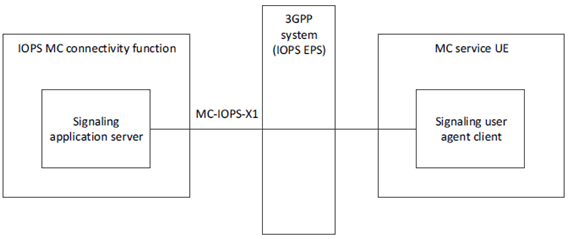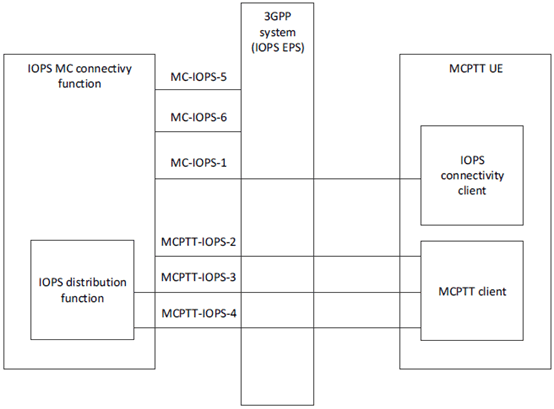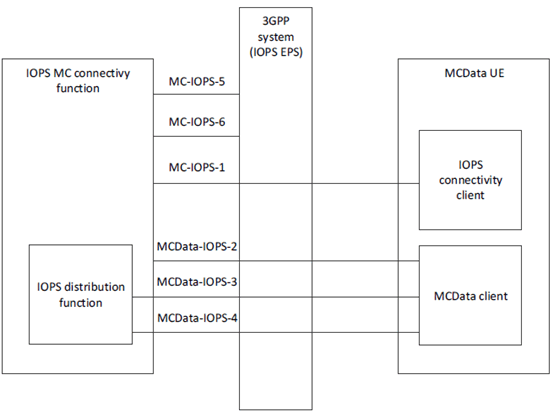Content for TS 23.180 Word version: 18.0.0
7 Functional model
7.1 General
7.2 Description of the planes
7.3 Functional model description
7.4 Functional entities description
7.5 Reference points
...
...
7 Functional model p. 12
7.1 General p. 12
The functional model to support MC services in the IOPS mode of operation in case of a backhaul failure consists of a set of functions and reference points.
7.2 Description of the planes p. 12
The functional model for the support of MC services in the IOPS mode of operation is defined as a series of planes to allow for the breakdown of the architectural description.
The application plane supports all the necessary functions to establish and provide MC services in the IOPS mode of operation. The application plane uses the services of the signalling control plane to establish the association of the users involved in an MC service. The signalling control plane also offers access to and control of services across MC services.
7.3 Functional model description p. 12
7.3.1 General p. 12
The application plane and signalling plane supporting the functional model for the IOPS mode of operation are described in this clause.
7.3.2 Functional model for the signalling control plane in the IOPS mode of operation p. 12
Figure 7.3.2-1 shows the common functional model for the signalling control plane in the IOPS mode of operation.

Figure 7.3.2-1: Functional model for the signalling control plane in the IOPS mode of operation
(⇒ copy of original 3GPP image)
(⇒ copy of original 3GPP image)
7.3.3 MCPTT functional model for the application plane in the IOPS mode of operation p. 12
Figure 7.3.3-1 shows the MCPTT functional model for the application plane in the IOPS mode of operation.

Figure 7.3.3-1: MCPTT functional model for the application plane in the IOPS mode of operation
(⇒ copy of original 3GPP image)
(⇒ copy of original 3GPP image)
In the model shown in Figure 7.3.3-1, the following apply:
- MCPTT-IOPS-2 carries signalling related to the support of multicast transmissions, e.g. MBMS bearer announcement, between the IOPS MC connectivity function and the MCPTT client.
- MCPTT-IOPS-3 carries signalling and media over IP unicast transmissions between the IOPS distribution function and the MCPTT client of the MCPTT UE.
- MCPTT-IOPS-4 carries signalling and media on downlink over IP multicast transmissions between the IOPS distribution function and the MCPTT client of the MCPTT UE.
7.3.4 MCData functional model for the application plane in the IOPS mode of operation p. 13
Figure 7.3.4-1 shows the MCData functional model for the application plane in the IOPS mode of operation.

Figure 7.3.4-1: MCData functional model for the application plane in the IOPS mode of operation
(⇒ copy of original 3GPP image)
(⇒ copy of original 3GPP image)
In the model shown in Figure 7.3.4-1, the following apply:
- MCData-IOPS-2 carries signalling related to the support of multicast transmissions, e.g. MBMS bearer announcement, between the IOPS MC connectivity function and the MCData client.
- MCData-IOPS-3 carries signalling and media over IP unicast transmissions between the IOPS distribution function and the MCData client of the MCData UE.
- MCData-IOPS-4 carries signalling and media on downlink over IP multicast transmissions between the IOPS distribution function and the MCData client of the MCData UE.
7.4 Functional entities description p. 14
7.4.1 Application plane p. 14
7.4.1.1 General p. 14
Entities within the application plane of an IOPS MC system provide application specific functions to support MC services in the IOPS mode of operation.
7.4.1.2 IOPS connectivity client p. 14
The IOPS connectivity client functional entity provides support for enabling that a user at the MC service client is registered and discovered by the IOPS MC system in the IOPS mode of operation. This functional entity is located in the MC service UE.
7.4.1.3 IOPS MC connectivity function p. 14
The IOPS MC connectivity function entity provides supporting MC services in the IOPS mode of operation. It includes registering and discovering users within the IOPS MC system. The IOPS MC connectivity functional entity represents a specific instantiation of the GCS AS described in TS 23.468 to manage unicast and multicast transmissions for group communication related sessions.
The IOPS MC connectivity function entity is supported by the signalling application server functional entity of the signalling control plane.
7.4.1.4 IOPS distribution function p. 15
The IOPS distribution function entity provides support for distributing the IP packets containing the MC service application data received from a MC service UE in the IOPS mode of operation.
By means of information provided by the IOPS MC connectivity function (e.g. IP addresses, transport layer ports), it will provide the following functionality:
- receiving uplink IP transmissions from the MC service UE by means of the MCPTT-IOPS-3 reference point for MCPTT and the MCData-IOPS-3 reference point for MCData;
- distributing the related IP packets via downlink IP unicast transmissions to MC service UEs by means of the MCPTT-IOPS-3 reference point for MCPTT and the MCData-IOPS-3 reference point for MCData;
- distributing the related IP packets via downlink IP multicast transmissions to MC service UEs by means of the MCPTT-IOPS-4 reference point for MCPTT and the MCData-IOPS-4 reference point for MCData.
7.4.1.5 MC service client p. 15
The MC service client functional entity, e.g. a MCPTT client and a MCData client, supporting the IOPS mode of operation acts as the user agent for the corresponding MC service transactions as well as all IOPS related application transactions.
7.4.2 Signalling control plane p. 15
7.4.2.1 Signalling user agent client p. 15
The signalling user agent client functional entity supports at the MC service client all required transactions related to the IOPS discovery. This includes supporting registration, publication, subscription and notification events.
7.4.2.2 Signalling application server p. 15
The signalling application server functional entity supports at the IOPS MC system all required transactions related to the IOPS discovery. This includes supporting registration, publication, subscription and notification events.
7.5 Reference points p. 15
7.5.1 Application plane p. 15
7.5.1.1 Reference point MC-IOPS-1 (between the IOPS MC connectivity function and the IOPS connectivity client) p. 15
The MC-IOPS-1 reference point, which exists between the IOPS MC connectivity function and the IOPS connectivity client, is used for IOPS related application signalling (e.g. registration, publication, subscription and notification events). The MC-IOPS-1 reference point utilizes the MC-IOPS-X1 reference point for transport and routing of the IOPS related signalling.
7.5.1.2 Reference point MCPTT-IOPS-2 (between the IOPS MC connectivity function and the MCPTT client) p. 15
The MCPTT-IOPS-2 reference point, which exists between the IOPS MC connectivity function and the MCPTT client, is used to communicate signalling related to the MBMS bearers utilized for multicast transmissions, e.g. MBMS bearer announcement in the IOPS mode of operation.
7.5.1.3 Reference point MCData-IOPS-2 (between the IOPS MC connectivity function and the MCData client) p. 16
The MCData-IOPS-2 reference point, which exists between the IOPS MC connectivity function and the MCData client, is used to communicate signalling related to the MBMS bearers utilized for multicast transmissions, e.g. MBMS bearer announcement in the IOPS mode of operation.
7.5.1.4 Reference point MCPTT-IOPS-3 (between the IOPS distribution function and the MCPTT client) p. 16
The MCPTT-IOPS-3 reference point, which exists between the IOPS distribution function and the MCPTT client, is used for IP unicast transmissions in uplink and downlink. The MCPTT-IOPS-3 reference point uses the SGi reference point defined in TS 23.002.
7.5.1.5 Reference point MCData-IOPS-3 (between the IOPS distribution function and the MCData client) p. 16
The MCData-IOPS-3 reference point, which exists between the IOPS distribution function and the MCData client, is used for IP unicast transmissions in uplink and downlink. The MCData-IOPS-3 reference point uses the SGi reference point defined in TS 23.002.
7.5.1.6 Reference point MCPTT-IOPS-4 (between the IOPS distribution function and the MCPTT client) p. 16
The MCPTT-IOPS-4 reference point, which exists between the IOPS distribution function and the MCPTT client, is used for IP multicast transmissions in downlink. The MCPTT-IOPS-4 reference point uses the MB2-U reference point defined in TS 23.468.
7.5.1.7 Reference point MCData-IOPS-4 (between the IOPS distribution function and the MCData client) p. 16
The MCData-IOPS-4 reference point, which exists between the IOPS distribution function and the MCData client, is used for IP multicast transmissions in downlink. The MCData-IOPS-4 reference point uses the MB2-U reference point defined in TS 23.468.
7.5.1.8 Reference point MC-IOPS-5 (between the IOPS MC connectivity function and the 3GPP system (IOPS EPS)) p. 16
The MC-IOPS-5 reference point, which exists between the IOPS MC connectivity function and the 3GPP system (IOPS EPS), is used to obtain unicast bearers with appropriate QoS from the IOPS EPS. The MC-IOPS-5 reference point utilizes the Rx interface of the EPS according to TS 23.203.
7.5.1.9 Reference point MC-IOPS-6 (between the IOPS MC connectivity function and the 3GPP system (IOPS EPS)) p. 16
The MC-IOPS-6 reference point, which exists between the IOPS MC connectivity function and the 3GPP system (IOPS EPS), is used to request the allocation and activation of multicast transport resources, i.e. MBMS bearers, during the IOPS mode of operation. The MC-IOPS-6 reference point uses the MB2-C interface as defined in TS 23.468.
7.5.2 Signalling control plane p. 16
7.5.2.1 Reference point MC-IOPS-X1 (between the signalling application server and the signalling user agent client) p. 16
The MC-IOPS-X1 reference point, which exists between the signalling application server and the signalling user agent client, is used to support the IOPS related application signalling (e.g. registration, publication, subscription and notification events).